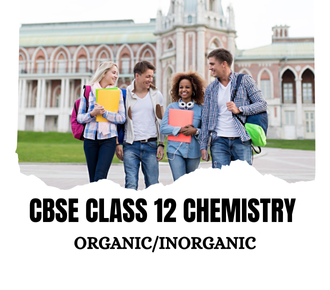- 9:30am - 6:30pm, Mon - Sun
- +91 7836034313
- R2-149 first floor M3M Cosmopolitan, sector 66 Gurugram 122102

Chemistry is a scoring subject if studied systematically. Organic and inorganic chemistry form a major part of the CBSE Class 12 syllabus and require both conceptual understanding and problem-solving skills. This blog is designed to help students prepare effectively with detailed notes, actionable tips, chapter-priority, past year questions (PYQs), mistakes to avoid, and a downloadable checklist.
For expert guidance, you can explore tutors at [/tutors], start with a [/free-trial], check plans at [/pricing], or find local tutors in Gurugram at [/city/gurugram/home-tutor]. Follow this guide to plan your study, clear doubts, and perform at your best in exams.
The CBSE Class 12 Chemistry syllabus is divided into physical, organic, and inorganic chemistry. In this guide, we are focusing on organic and inorganic topics which form an essential part of scoring high in exams.
General Organic Chemistry
Hybridization, inductive effect, resonance
Nomenclature and functional groups
Alcohols, Phenols, and Ethers
Preparation methods, reactions, uses
Aldehydes, Ketones and Carboxylic Acids
Mechanisms, structure, properties
Organic Compounds Containing Nitrogen
Amines, diazonium salts
Biomolecules
Carbohydrates, proteins, vitamins
Polymers
Types and applications
Chemistry in Everyday Life
Drugs, detergents, food preservatives
The p-Block Elements
Group 15, 16, 17, and 18 elements – structure, bonding, reactions
The d-Block Elements
Transition metals, coordination compounds
The f-Block Elements
Lanthanides and actinides
Coordination Compounds
Nomenclature, bonding theories, stability
Environmental Chemistry
Pollution, waste management
Practice mechanism-based reactions regularly.
Revise nomenclature and reaction conditions.
Focus on coordination chemistry concepts and diagrams.
Solve numericals involving bonding and stability constants.
Some chapters are frequently tested and should be given priority during preparation. Below is a suggested priority list based on CBSE patterns.
Alcohols, Phenols, and Ethers – Definitions, reaction mechanisms, uses
Aldehydes, Ketones and Carboxylic Acids – Derivations and reaction mechanisms
The p-Block Elements – Structure, properties, and equations
Coordination Compounds – Bonding, geometry, stability
Organic Compounds Containing Nitrogen – Amines and diazonium salts
General Organic Chemistry – Fundamentals, inductive and resonance effects
Polymers – Types, uses, industrial importance
The d-Block Elements – Properties and applications
The f-Block Elements – Overview and reaction tendencies
Biomolecules – Applications and brief structures
Environmental Chemistry – Descriptive topics
Chemistry in Everyday Life – Important but limited weightage
Instead of memorizing reactions, learn the step-by-step mechanism. This approach helps in deriving answers during exams.
Organic reactions and inorganic properties require consistent revision. Create flashcards for quick recall.
Solving PYQs helps you identify commonly asked questions and build confidence.
Well-structured answers with proper spacing, headings, and diagrams earn higher marks.
Devote equal time to organic and inorganic topics. Don’t ignore inorganic chemistry as it requires conceptual clarity.
Create charts linking reactants, products, and conditions. Visual learning enhances memory.
Where applicable, such as bonding theories or stability constants, solve numericals to avoid silly mistakes.
Explain the mechanism of nucleophilic substitution in alcohols.
Write the preparation and reactions of ethers.
Derive the Aldol condensation reaction.
Discuss the structure and reactions of carboxylic acids.
Explain the significance of amines in organic reactions.
Describe the preparation and properties of polymers used in daily life.
Explain the electronic configuration and oxidation states of group 15 elements.
Derive the stability constant expression for coordination compounds.
Discuss the bonding theories used in transition metals.
Write equations representing the reactions of halogens.
Explain the environmental effects of chemical pollutants.
Derive the geometry of coordination complexes using VSEPR theory.
Solve at least 50 questions from past year papers.
Focus on mechanism-based questions for organic chemistry.
Work on coordination compound structures and numerical problems.
Students often memorize reaction sequences without knowing how and why they happen. Always understand mechanisms.
Missing catalysts, temperature, or solvents leads to incomplete answers. Always mention reaction conditions.
Diagrams such as molecular shapes, hybridization, and bonding patterns carry marks. Practice them regularly.
Students avoid inorganic numerical problems like stability constants. Practice until confident.
Spending too much time on descriptive questions reduces time for numericals and diagrams.
Periodic revision helps retain information. Don’t cram before exams; revise weekly.
Reactions like oxidation and substitution may look similar but have different mechanisms. Clarify concepts before exams.
You can download the checklist from [/city/gurugram/home-tutor]. It helps you track your progress and revise effectively.
✔ Chapters completed
✔ Reaction mechanisms understood
✔ Numerical problems practiced
✔ Diagrams drawn and revised
✔ Weekly revision done
✔ Doubts clarified with tutors
✔ Time management improved
✔ Mock tests attempted
Use this checklist weekly to ensure steady progress and avoid last-minute stress.
Get customized study schedules based on your strengths and weak areas.
Get instant doubt-clearing help through one-on-one sessions.
Take regular assessments with detailed feedback to track performance.
Choose between online or in-person tutoring. Find tutors near you at [/city/gurugram/home-tutor].
Begin your preparation with a [/free-trial] and explore learning plans at [/pricing].
CBSE Class 12 Chemistry – Organic and Inorganic topics are scoring if approached with a structured plan. By following this guide, understanding reaction mechanisms, solving past year questions, avoiding common mistakes, and using a downloadable checklist, you can maximize your performance in exams.








